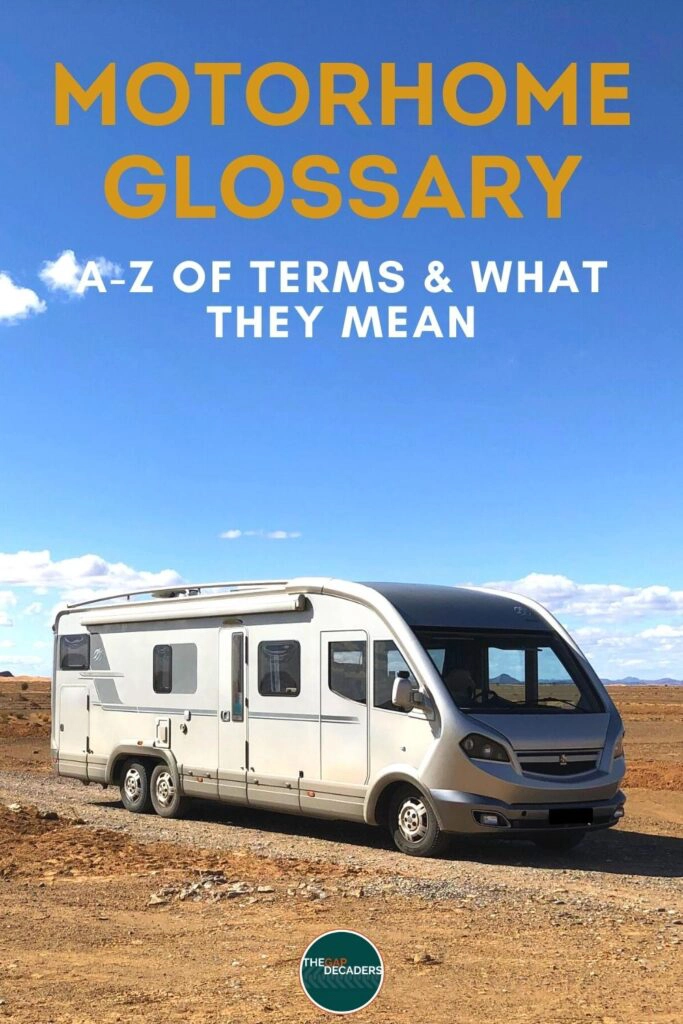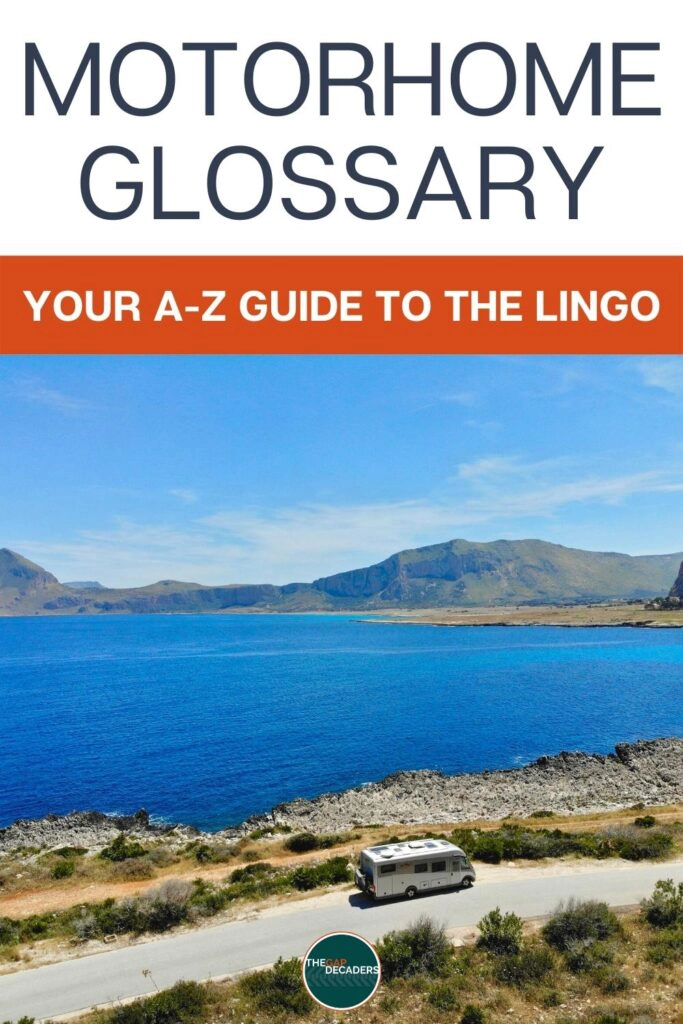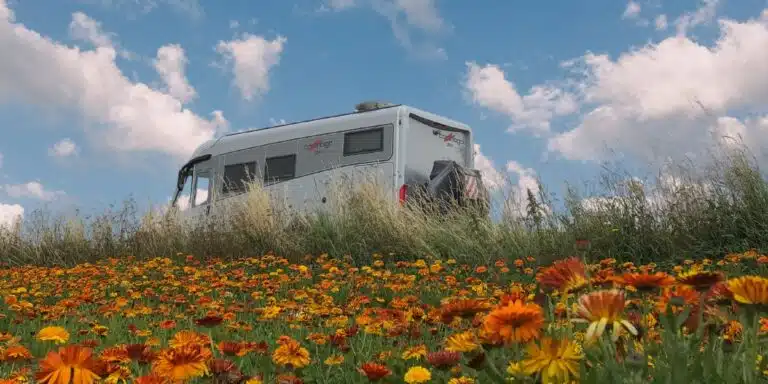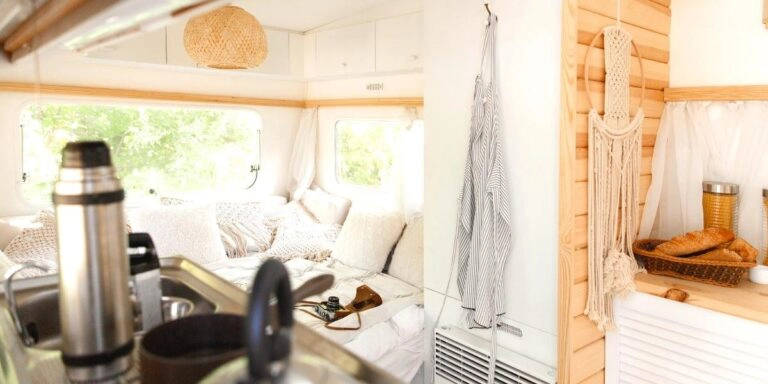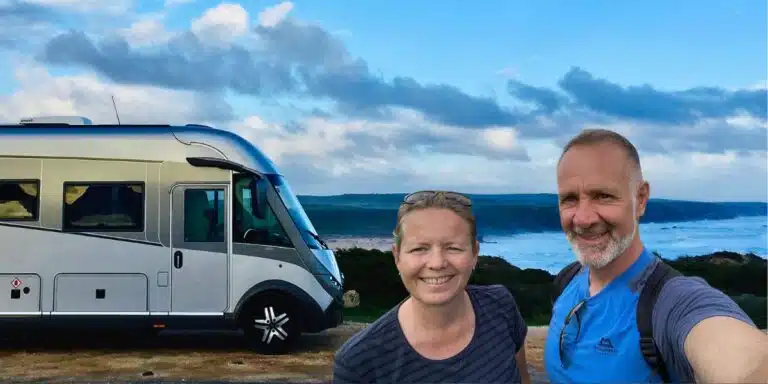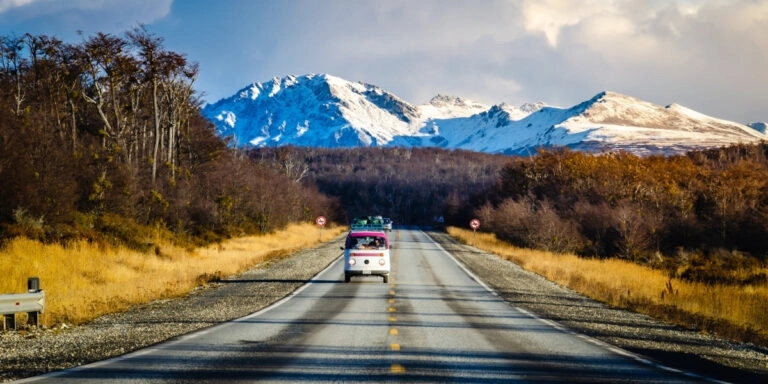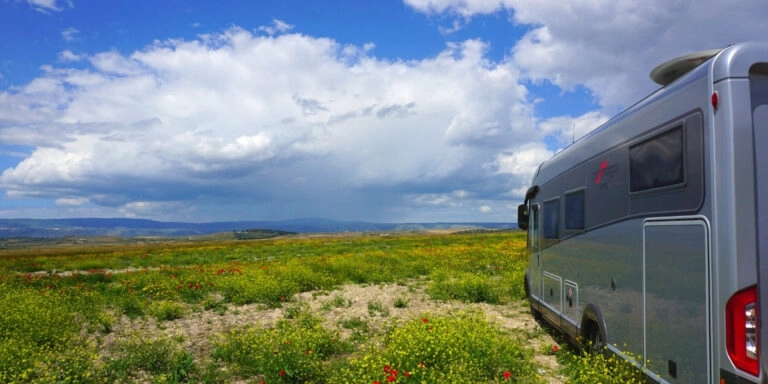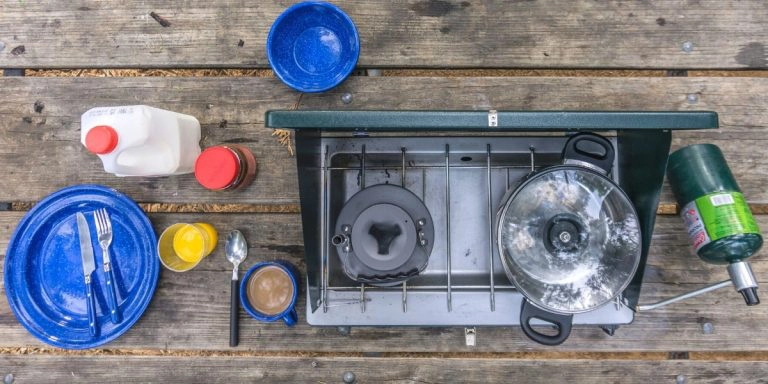This post may contain affiliate links, from which we earn an income. Click here to read our affiliate policy.
Motorhome Lingo Explained
Are you a motorhome newbie feeling confused by all the different terminology? We’ve all been there – wondering what this abbreviation means, or what that acronym stands for is a part of learning to be a motorhomer.
To support you on that journey, we’ve put together a motorhome glossary of over 100 motorhome terms with brief explanations for each to help you work it all out!
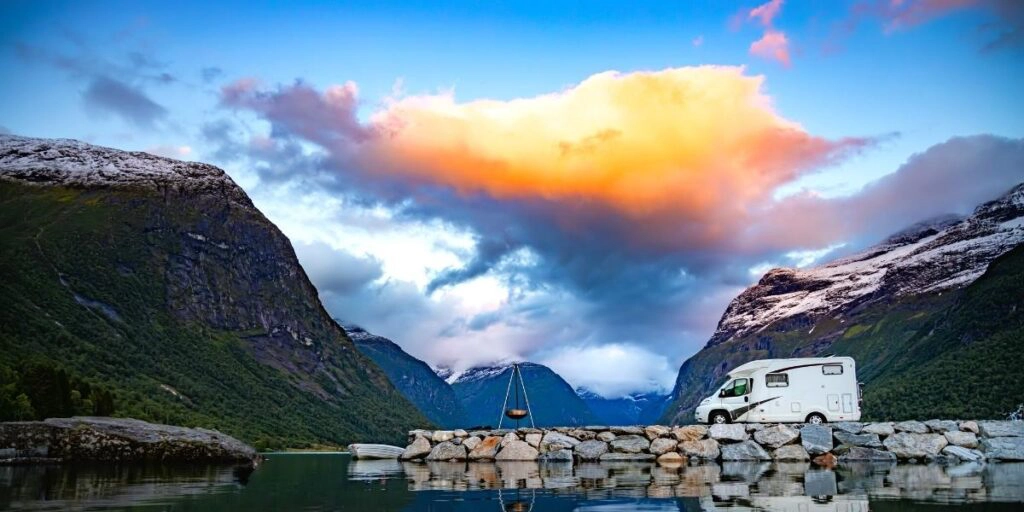
12 Volt DC
A motorhome’s electrical system. 12 volt direct current is supplied by on board leisure batteries to run the lights, fridge, stereo, radio, water pump, fans and other equipment in the living area.
Accident Recognition System
An integral sensor fitted to your gas system that stops any gas flow immediately it senses a collision, meaning you can travel with the gas turned on.
A Class
A specific type of motorhome built from the floor up, using a complete coachbuilt body on a chassis cowl. Called an ‘integrated’ in the USA.
ACSI
ACSI is Europe’s leading campsite specialist. Get the Camping Card ACSI for discounts at European campsites in the low season.
A Frame
Towing framework used to tow a small car behind a motorhome. An accepted method of towing a car in the UK illegal in many European countries.
Aire
The French word aire literally translates to ‘area’. Over the years it has come to describe an area designated for overnight motorhome parking in much of Europe and to provide access to essential services such as fresh water and waste disposal.
Learn more about motorhome aires here.
AES Fridge
A type of three way fridge that automatically selects the best source of power.
Alde
A wet heating system which uses liquid-filled radiators creating a convection based heating system rather than a blown air system. Alde systems also heat your shower and washing up water.
Approved Workshop
Member of a scheme operated by trade body the NCC, which inspects and lists specialist service centres capable of carrying out all levels of work on every aspect of the habitation area, as well as the bodywork, of motorhomes, campervans and caravans.
Awning
Extra shelter or living space for any motorhome or campervan. This can be in the form of a canopy that’s permanently fixed to the length of the vehicle and winds out to provide shelter, or a fuller awning that’s more of a tent-like structure that fixes to your motorhome via a rail or similar, to give you extra seating, sleeping or storage space.
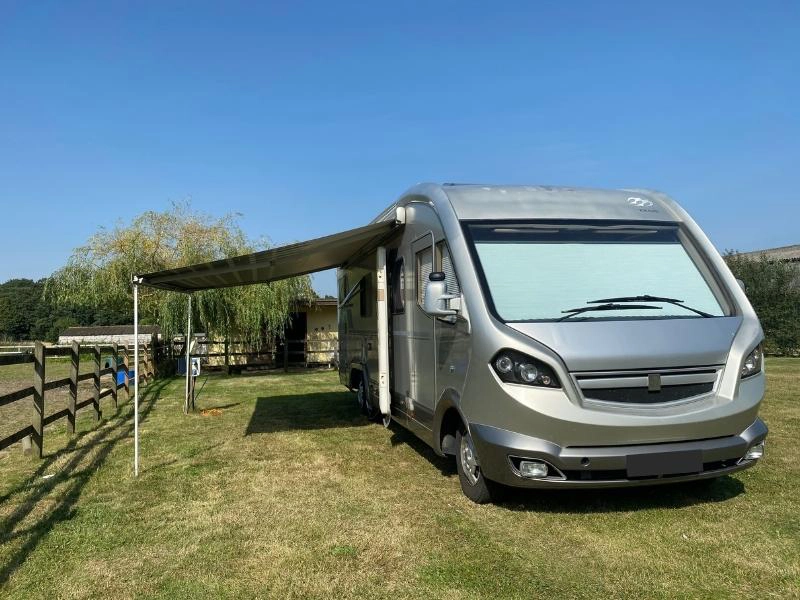
Axle Weight
The weight placed on any axle, front or back. It is illegal to exceed axle weight limits, which are set by the base vehicle manufacturer.
Base Vehicle
The donor vehicle that provides the foundations for any motorhome or campervan conversion. Common base vehicles are VW Transporters and Mercedes Benz Sprinters (for campervan conversions), and Fiat Ducato or Peugeot Boxer (for motorhomes).
Barn Doors
Twin side-hinged rear doors at the back of a campervan, which give access to the rear of the van (usually a bed with storage underneath).
Belted Seats
The number of seats fitted with belts and therefore safe for travel.
Berths
The number of people a motorhome can accommodate for sleeping. It is not uncommon to find motorhomes with more berths than belted seats – check this if you’re buying.
Black Waste
Refers to toilet waste held in either a toilet cassette or the holding tank of a gravity flush toilet.
Blown Air
A system of heating the interior of a motorhome with hot air, using pipes and outlets throughout the habitation area.
Boondocking
The American term for wild camping.
Cab
The driving area of a motorhome or campervan with a driver and passenger seat, sometimes called the ‘cockpit’. The driver’s seat is sometimes called a ‘captain’s chair’ and both may swivel to face the habitation area, where the cab is not seperate from the living quarters.
Campervan
A camper van, sometimes called a camper, is essentially a panel van (of white van man fame) that has been converted to add living space. The type of van usually used will be a commercial vehicle like a Fiat Ducato, Mercedes Sprinter, Peugeot Boxer, Ford Transit or Renault Trafic, although you could convert any type of panel van. The can will either be a high top version or will have a pop top roof, creating standing room in the van.
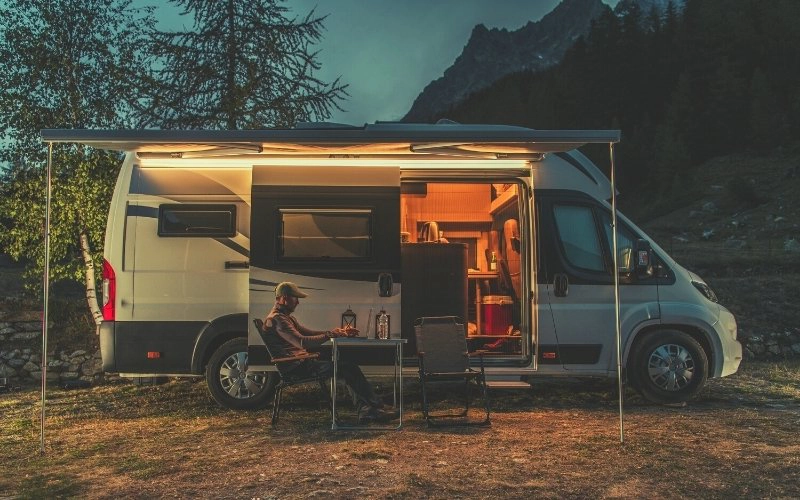
Cassette Toilet
A plumbed-in, flushing (electric or manual) toilet with a holding tank underneath, known as a cassette, that can be easily removed when you want to empty the contents.
Learn more about motorhome toilets here.
CaSSOA
Caravan Storage Site Owners’ Association. CaSSOA approve motorhome and campervan storage sites across the UK, ensuring they reach a level of accredited recognised by your motorhome insurance company.
Learn more about motorhome storage here.
CCC
The Camping and Caravanning Club. A not-for-profit organisation involved with all aspects of camping based in the United Kingdom. An annual fee is paid to gain membership for dicsounts on campsites and other offers.
CDP
Chemical Disposal Point. A designated dump station on a campsite for emptying toilet cassettes. Also known as an elsan point.
Certified Locations
Member only sites run by the Caravan and Motorhome Club.
Certified Sites
Member only sites run by the Camping and Caravanning Club.
Converter/Charger
When connected to an AC power outlet, this electronic device converts 240V AC to 12V DC to run 12V equipment. It usually also charges the leisure batteries.
CMC
The Caravan and Motorhome Club. A not-for-profit organisation involved with all aspects of camping based in the United Kingdom. An annual fee is paid to gain membership for dicsounts on campsites and other offers.
The Complete Guide for Motorhome Beginners
With our best motorhome tips and advice about motorhome basics to where to park for the night and ideas for touring Europe, this is the ultimate resource for motorhome newbies.
This motorhoming ebook will help you get to grips with the inner workings of your motorhome, giving you confidence for life on the road and your first motorhome adventure!
Corner Steadies
Sometimes called legs, rear corner steadies are manually lowered or raised by turning a threaded spindle. The legs make contact with the ground and provide stabilisation when people move around inside the motorhome.
Coachbuilt
The term ‘coach built’ refers to a motorhome based on a chassis-cab, the same as a campervan, except with a coachbuilt motorhome, only the chassis and cab is retained. The coachbuilder adds the body to the rear to house the habitation area.
Delamination
A failure of adhesive within the laminated assembly and components such as the roof, sidewall or floor. Often caused by water ingress or damp.
Dinette
A seating arrangement in the habitation area where two seats face each other on either side of a table.
Double Floor
A specific way of making the floor of a motorhome. The double floor allows for optimum insulation as well as the opportunity to build in floor lockers and run pipework for heating, effectively winterising the vehcile.
Draining Down
If you’re storing your motorhome for a long period, especially thought winter, it’s essential to remove all water from the fresh and waste water tanks and associated pipework, including taps and showerheads to prevent freezing, before laying-up.
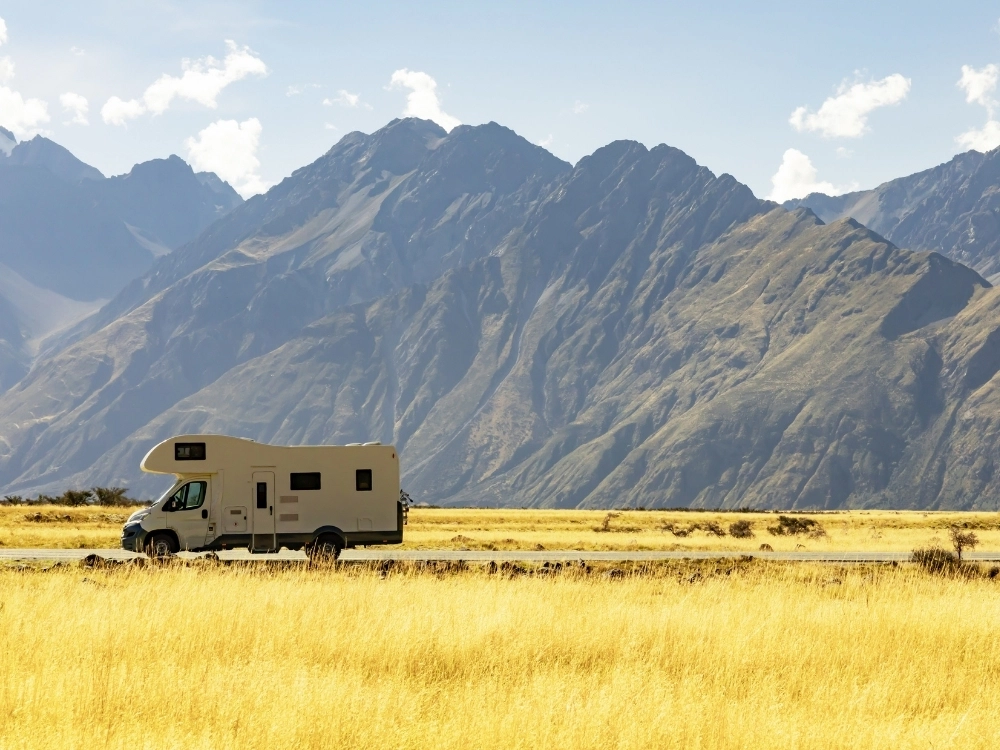
Drop-Down Bed
A bed (usually a double) that stores away at almost ceiling level when not needed and is dropped down, manually or electrically, to be made ready for sleeping.
Learn more about motorhome layouts here.
Dump Station
The colloquial name for a motorhome service point where waste can be disposed of.
EHU
Electric hook up or mains hook up. When you go to a campsite or motorhome aire, electric hook up with a specific cable provides your vehcile with 230V power – this can also charge your leisure battery. This is sometimes also referred to as shore power.
Learn more about motorhome electrics here.
Elevating Roof
Known as a pop top roof, this is a canvas-sided roof section that pushes up once you’re parked up, to provide extra standing space and/or beds in a campervan or van conversion.
Electric Step
A slide out step at the habitation door that comes out electrically. It’s usually wired to retract automatically when you start your engine.
French Bed
A permanent double bed, or almost double, with a cutaway section at the foot end, to allow easier access to the washroom which is adjacent. adjacent).
Fresh Water Tank
A tank, located either inside or under the floor, for storing a ready supply of fresh water to any taps or showerhead via a pump.
Learn more about motorhome water systems here.
Full Timing
Living permanently in a motorhome when you have no other place to live. This requires specialist full-timing insurance.
Learn more about living in a motorhome here.
Garage
A large storage area accessible from outside (sometimes also inside) a motorhome. Some garages are big enough to carry bikes and scooters.
Gaslow
A refillable LPG system which means your gas bottles can be filled from a pump on a garage forecourt. Similar to the Gasit system.
Learn more about motorhome gas systems here.
Gravity Flush Toilet
Gravity flush toilets are often operated by a foot pedal and the waste drops into a large holding tank sited directly underneath the toilet. These holding tanks are emptied via a sewer hose.
Grey Water
Any waste water created as a result of using your motorhomes appliances, except toilet waste, known as black waste or black water. Most motorhomes have waste water tanks to store grey water until it cen be dispoed of in the correct place, known as a dump station.
Grip Mats
Specially designed mats for slipping under a motorhome’s driven wheels, to prevent wheelspin and/or getting stuck in muddy conditions.
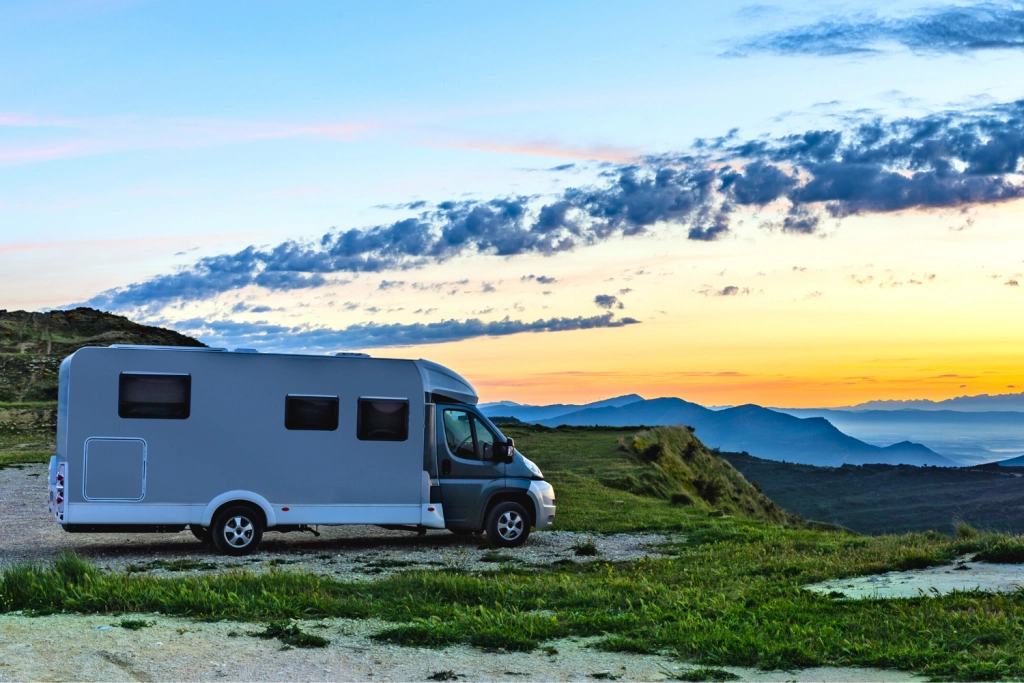
GRP
Glass Reinforced Plastic, also known as glass-fibre or fibreglass, is an extremely durable product used in the manufacture of
GTW
Gross Towing Weight. The GTW is the maximum allowable combined maximum authorised mass of your motorhome, plus the mass of the trailer and cargo in the trailer.
GVW
Gross Vehicle Weight. Used to describe the weight of the vehicle in full travelling trim i.e. fully laden and ready for a trip, the absolute most your motorhome can weigh. The same as MAM – maximum authorised mass, MTPLM – maximum technically permissible laden mass and PMW – permissible maximum weight.
Learn more about motorhome weights here.
Habitation Area
The living quarters of a motorhome.
Habitation Check
A recommended annual service for the living aspects of all motorhomes, often referred to as a hab check. It involves servicing (usually anually) of the habitation side, including water, gas and electrical systems, and helps ensure overall safety of the motorhome. It is not a legal requirement, but may be a warranty requirement for new motorhomes.
Learn more about habitation checks here.
Habitation Door
The main entrance to the living quarters in a motorhome.
High Top
A manufacturers version of a van where the body is higher than usual. Most manufacturers make a standard body and a high top option.
Inverter
A device for changing 12V leisure battery power to 230V, meaning normal three pin sockets can be used in the habitation area.
Island Bed
A permanent double bed with access around three sides.
Leisure Battery
Sometimes referred to as an auxiliary battery, the deep cycle leisure battery is what provides a supply of 12V power to the habitation electrical system of a motorhome or campervan. Leisure batteries can be charged from electric hook up, solar power or your vehicles engine. This is not the same as a starter battery which is designed to start your vehicle.
Learn more about motorhome leisure batteries here.
Levelling Ramps or Chocks
Wedges for driving on to level up your vehicle when you’re parked on uneven terrain.
Low Profile Motorhome
A type of coach built motorhome, a low-profile motorhome retains the cab of the base vehicle and the top of the cab is open to the habitation part of the vehicle, often with a large roof light, giving the vehicle a much sleeker look.
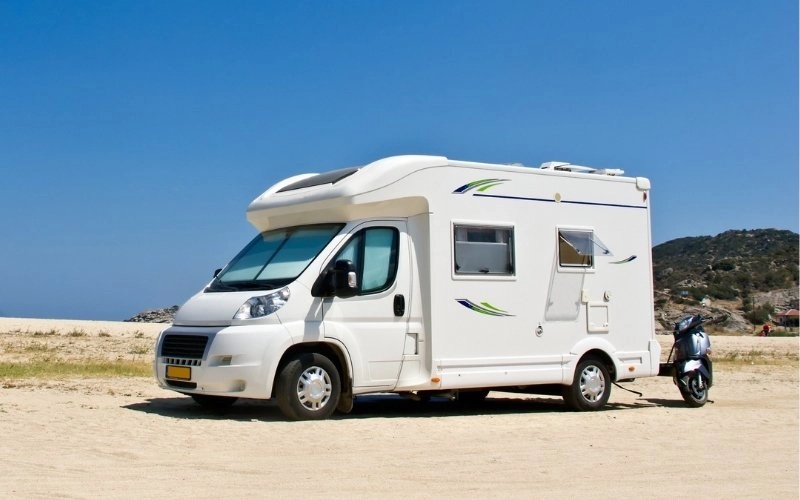
LPG
Liquefied Petroleum Gas. Butane (not good in winter as it won’t produce gas below 0°C) or propane (best for all season use), or a mix of both, this is the gas used to fire appliances such as cookers, heating and hot water systems in motorhomes. LPG is called GPL in Europe. LPG can be supplied in bottles or from the pump to refillable canisters.
LWB
Long wheelbase, referring to the original base vehicle in a campervan conversion.
MAM
Maximum Authorised Mass. Used to describe the weight of the vehicle in full travelling trim i.e. fully laden and ready for a trip, the absolute most your motorhome can weigh. The same as GVW – gross vehicle weight, MTPLM – maximum technically permissible authorised mass and PMW – permissible maximum weight.
MPPT
Maximum power point tracker. An electronic DC to DC converter/charger that optimizes the match between solar panels and the leisure battery, keeping your batteries charged at the right levels.
MRO
Mass in running order, sometimes called unladen weight or kerbweight. The MRO (or MiRO) usually includes a 75kg allowance for the driver, fuel tank filled to 90%, one full gas cylinder and any fluids if a “wet” central heating system is fitted. It also assumes the fresh and waste water tanks are empty. Your vehcile manufacturer will be able to give you the accurate MRO – it’s an important number as deducting this from the GVW or gross vehicle weight, gives you your payload figure.
Motor Caravan
Defined by the DVLA as “a special purpose M category (passenger carrying) vehicle constructed to include living accommodation which contains seats and a table, sleeping accommodation which may be converted from the seat, scooking facilities and storage facilities which must be rigidly fixed to the living compartment; however, the table may be designed to be easily removable.”
Motorhome
The generic term for all kinds of motorised leisure vehicles, including campervans, but most commonly for coachbuilt and a-class models.
Motorhome Service Point
A drive-through area where you can stop to fill up with fresh water, dump any waste water and empty your cassette toilet. In the UK, motorhome service areas tend to be on campsites. In Europe, you can also find them at motorhome aires (with or without overnight facilities), garages and supermarkets.
MTPLM
Maximum Technically Permissible Laden Mass. Used to describe the weight of the vehicle in full travelling trim i.e. fully laden and ready for a trip, the absolute most your motorhome can weigh. The same as GVW – gross vehcile weight, MAM – maximum authorised mass and PMW – permissible maximum weight.
NCC (National Caravan Council)
The trade body for motorhomes and campervans in the UK, also the organiser of the UK’s two largest shows.
Off Grid Camping
Staying in your motorhome without an electric hook up.
Learn more about free motorhome camping here.
Overcab
A type of coach built motorhome, an over-cab motorhome retains the cab of the base vehicle and has a large bulbous area with a permanent double bed over the driver and passenger seats, and the rear of the cab open to the habitation area.
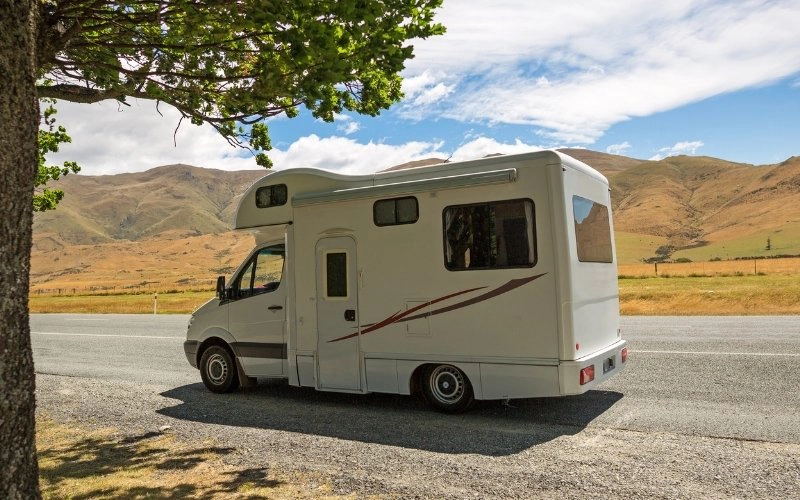
Panel Van
A light commercial vehicle, with or without windows, but which provides the base for a van conversion.
Payload
The weight you can add to your motorhome when you load up with water, gas, people, food and everything else you want to carry for a trip. You can work out your motorhome payload by deducting the MRO (or weight from a weighbridge when empty) from the MAM.
Learn more about payload here.
PDI
Pre-delivery inspection. An inspection of the motorhome by a dealership or trader before it’s sold and handed over to the customer.
Pitch
A designated spot on a campsite for a motorhome or campervan to park up overnight. Pitches can be grass or hardstanding, such as concrete, asphalt or gravel, and usually come with plug-in facilities starting with EHU but possibly also fresh water tap, waste water disposal and even connection to a TV aerial (in the UK). These pitches are often referred to as serviced pitches or super pitches.
Learn more about pitches and campsites here.
PVC
Panel van conversion.
PMW
Maximum Technically Permissible Laden Mass. Used to describe the weight of the vehicle in full travelling trim i.e. fully laden and ready for a trip, the absolute most your motorhome can weigh. The same as GVW – gross vehicle weight, MTPLM – maximum technically permissible authorised mass and MAM – maximum authorised mass.
Regulator
Usually a reference to the fitting that allows the flow of gas from the cylinder to the appliances onboard any motorhome. Many European countries use different regulaors to the UK.
Rock and Roll Bed
A rear seating arrangement found in campervans, that folds down into a (small) double bed.
RV
Recreational vehicle. The American term for a motorhome.
Safari Room
An awning that has panels which can be affixed to create a complete room protected on all sides.
Safefill
Purpose-made refillable gas bottles that can be filled at the pump on a garage forecourt.
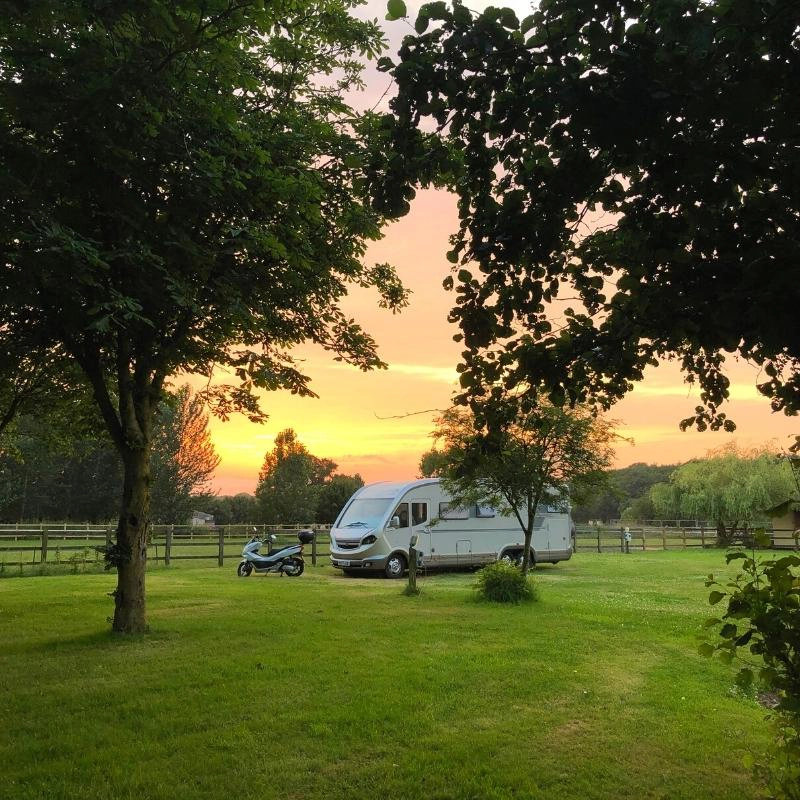
Self-Build
A campervan conversion that’s been carried out by an individual, usually for personal use.
Shore Power
Electric hook up to a 230V system. The term is boating terminology but is commonly used in campervan and overland vehicles.
SOG
Fitted to your cassette toilet, a SOG is a 12V electric fan which creates a negative pressure and extracts any unwanted smells from the toilet cassette whenever you open the blade to flush, meaning no chemicals are required.
Sosta
The same as an aire. The Italian word sosta literally translates to ‘stopover’. Over the years it has come to describe an area designated for overnight motorhome parking in Italy and to provide access to essential services such as fresh water and waste disposal.
Slide-Out
A section of bodywork that slides out at the side of the habitation area to give more living space when a motorhome is parked up. Often found on American RV’s.
Step-In Height
The depth from the ground to the first step at the habitation door.
Swivel Seat
A cab seat with a fitted mechanism that allows it to be turned around to face the rest of the living quarters, so it can be used as seating when stationary.
Three Way Fridge
An absorption fridge which can be powered by 230V when hooked up to mains electric, gas or 12V when the vehicles engine is running.
Transverse bed
A permanent bed, such as a bunk, French or island, that sits across the vehicle from side to side.
Twin Beds
Two fixed single beds that are across from each other.
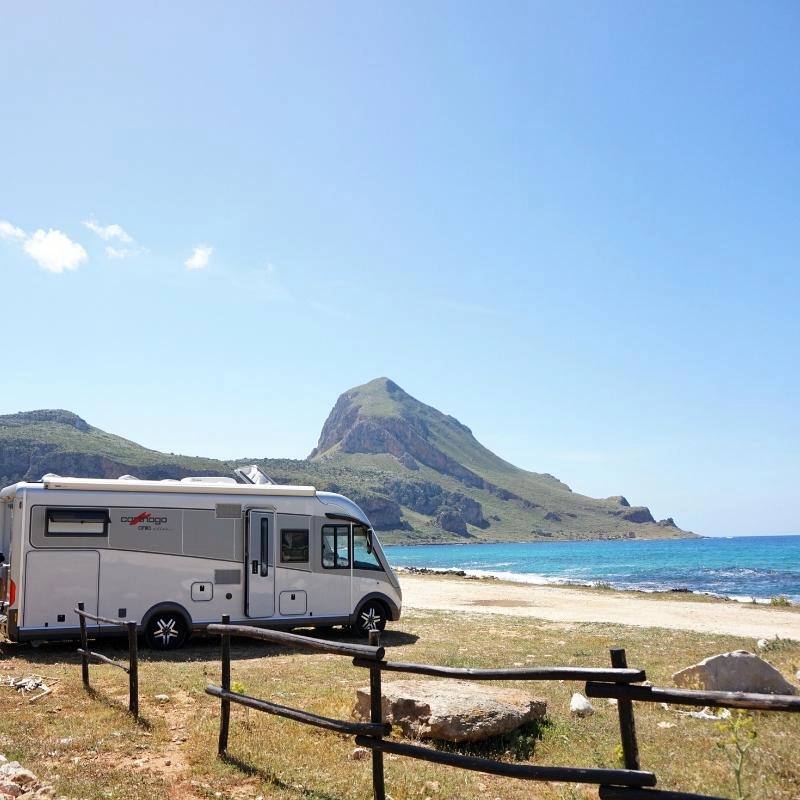
Van Conversion
A panel van that’s been converted into a campervan. Get the best books about van life and van conversions here.
Water Ingress
A particular problem where water gets into the body of a campervan or motorhome and can cause damage to the structure.
Wild Camping
Using your motorhome and campervan for overnight stays anywhere other than on an official campsite.
Learn more about wild camping here.
Winterised
The definition of a winterised motorhome is as varied as the number of motorhome manufacturers! The best winterised motorhomes have all the pipes and water tanks inside the van, usually within a double insulated floor. Some winter proof motorhomes use electrical heating elements, lagging and ‘silver bubbles’ to wrap and coat their vulnerable parts and use thermal insulation within walls, ceiling and floor.
Learn more about motorhoming in winter here.
Are you looking for more motorhome beginners resources? Check out these top posts…
Motorhoming Tips for Beginners: Essential Know How for Motorhome Life
The Best Motorhome Gadgets (that you will actually use!)
Motorhome Life: Should You Sell Up to Travel Like We Did?
Must-Have Storage Ideas for Your Home on Wheels
Motorhoming Made Easy – Your Top 20 Questions Answered
101+ Motorhome Essentials You Need + Packing Checklist
Love it? Pin it!
